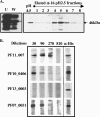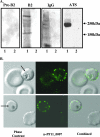Characterization of the antibody response against Plasmodium falciparum erythrocyte membrane protein 1 in human volunteers
- PMID: 17923524
- PMCID: PMC2168328
- DOI: 10.1128/IAI.00327-07
Characterization of the antibody response against Plasmodium falciparum erythrocyte membrane protein 1 in human volunteers
Abstract
The immune response against the Plasmodium falciparum variant surface antigen P. falciparum erythrocyte membrane protein 1 (PfEMP1) is a key component of clinical immunity against falciparum malaria. In this study, we used sera from human volunteers who had been infected with the P. falciparum 3D7 strain to investigate the development, specificity, and dynamics of anti-PfEMP1 antibodies measured against six different strain 3D7 Duffy binding-like domain 1alpha (DBL1alpha) fusion proteins. We observed that a parasitemia of 20 to 200 infected erythrocytes per mul was required to trigger an antibody response to DBL1alpha and that antibodies against one DBL1alpha variant cross-react with other DBL1alpha variants. Both serum and purified immunoglobulin Gs (IgGs) were able to agglutinate infected erythrocytes, and purified anti-DBL1alpha IgGs bound to the live infected red blood cell surface in a punctate surface pattern, confirming that the IgGs recognize native PfEMP1. Analysis of sera from tourists naturally infected with P. falciparum suggests that the anti-PfEMP1 antibodies often persisted for more than 100 days after a single infection. These results help to further our understanding of the development of acquired immunity to P. falciparum infections.
Figures



Similar articles
-
The Plasmodium falciparum erythrocyte invasion ligand Pfrh4 as a target of functional and protective human antibodies against malaria.PLoS One. 2012;7(9):e45253. doi: 10.1371/journal.pone.0045253. Epub 2012 Sep 20. PLoS One. 2012. PMID: 23028883 Free PMC article.
-
A sequence in subdomain 2 of DBL1α of Plasmodium falciparum erythrocyte membrane protein 1 induces strain transcending antibodies.PLoS One. 2013;8(1):e52679. doi: 10.1371/journal.pone.0052679. Epub 2013 Jan 15. PLoS One. 2013. PMID: 23335956 Free PMC article.
-
Detection of naturally acquired, strain-transcending antibodies against rosetting Plasmodium falciparum strains in humans.Infect Immun. 2024 Jul 11;92(7):e0001524. doi: 10.1128/iai.00015-24. Epub 2024 Jun 6. Infect Immun. 2024. PMID: 38842304 Free PMC article.
-
The role of antibodies to Plasmodium falciparum-infected-erythrocyte surface antigens in naturally acquired immunity to malaria.Trends Microbiol. 2002 Feb;10(2):55-8. doi: 10.1016/s0966-842x(01)02278-8. Trends Microbiol. 2002. PMID: 11827798 Review.
-
PfEMP1 - A Parasite Protein Family of Key Importance in Plasmodium falciparum Malaria Immunity and Pathogenesis.Adv Parasitol. 2015 Apr;88:51-84. doi: 10.1016/bs.apar.2015.02.004. Epub 2015 Mar 23. Adv Parasitol. 2015. PMID: 25911365 Review.
Cited by
-
Comprehensive analysis of Fc-mediated IgM binding to the Plasmodium falciparum erythrocyte membrane protein 1 family in three parasite clones.Sci Rep. 2019 Apr 15;9(1):6050. doi: 10.1038/s41598-019-42585-0. Sci Rep. 2019. PMID: 30988351 Free PMC article.
-
Induction of strain-transcending antibodies against Group A PfEMP1 surface antigens from virulent malaria parasites.PLoS Pathog. 2012;8(4):e1002665. doi: 10.1371/journal.ppat.1002665. Epub 2012 Apr 19. PLoS Pathog. 2012. PMID: 22532802 Free PMC article. Clinical Trial.
-
The kinetics of antibody binding to Plasmodium falciparum VAR2CSA PfEMP1 antigen and modelling of PfEMP1 antigen packing on the membrane knobs.Malar J. 2010 Apr 19;9:100. doi: 10.1186/1475-2875-9-100. Malar J. 2010. PMID: 20403153 Free PMC article.
-
Specific antibody responses against membrane proteins of erythrocytes infected by Plasmodium falciparum of individuals briefly exposed to malaria.Malar J. 2010 Oct 11;9:276. doi: 10.1186/1475-2875-9-276. Malar J. 2010. PMID: 20932351 Free PMC article.
-
Choice of Drug for Malaria Prevention During Pregnancy Does Not Affect Infant Serologic Responses to Plasmodium falciparum Erythrocyte Membrane Proteins 1.Open Forum Infect Dis. 2025 Jan 23;12(2):ofaf037. doi: 10.1093/ofid/ofaf037. eCollection 2025 Feb. Open Forum Infect Dis. 2025. PMID: 39963702 Free PMC article.
References
-
- Barragan, A., V. Fernandez, Q. Chen, A. von Euler, M. Wahlgren, and D. Spillmann. 2000. The duffy-binding-like domain 1 of Plasmodium falciparum erythrocyte membrane protein 1 (PfEMP1) is a heparan sulfate ligand that requires 12 mers for binding. Blood 95:3594-3599. - PubMed
-
- Baruch, D. I., X. C. Ma, H. B. Singh, X. Bi, B. L. Pasloske, and R. J. Howard. 1997. Identification of a region of PfEMP1 that mediates adherence of Plasmodium falciparum infected erythrocytes to CD36: conserved function with variant sequence. Blood 90:3766-3775. - PubMed
-
- Beeson, J. G., E. J. Mann, T. J. Byrne, A. Caragounis, S. R. Elliott, G. V. Brown, and S. J. Rogerson. 2006. Antigenic differences and conservation among placental Plasmodium falciparum-infected erythrocytes and acquisition of variant-specific and cross-reactive antibodies. J. Infect. Dis. 193:721-730. - PMC - PubMed
-
- Bruce-Chwatt, L. J. 1952. Malaria in African infants and children in southern Nigeria. Ann. Trop. Med. Parasitol. 46:173-200. - PubMed
-
- Buffet, P. A., B. Gamain, C. Scheidig, D. Baruch, J. D. Smith, R. Hernandez-Rivas, B. Pouvelle, S. Oishi, N. Fujii, T. Fusai, D. Parzy, L. H. Miller, J. Gysin, and A. Scherf. 1999. Plasmodium falciparum domain mediating adhesion to chondroitin sulfate A: a receptor for human placental infection. Proc. Natl. Acad. Sci. USA 96:12743-12748. - PMC - PubMed
Publication types
MeSH terms
Substances
Grants and funding
LinkOut - more resources
Full Text Sources
Other Literature Sources
Research Materials

